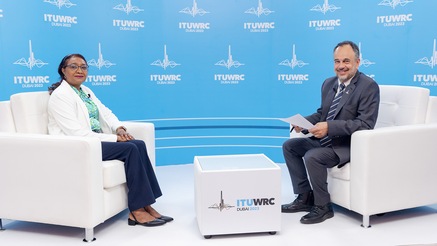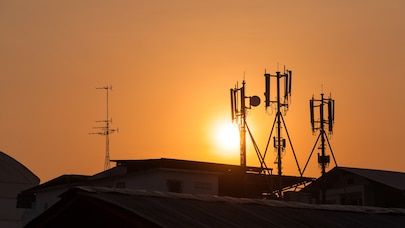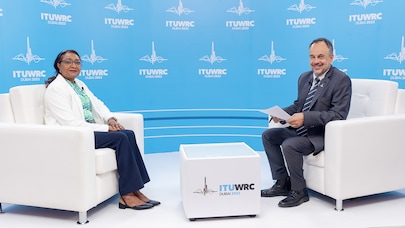Spectrum policy
Mobile broadband is the cornerstone of connectivity for citizens and businesses worldwide and spectrum is a fundamental enabler of the mobile wireless communications. It is also a scarce resource that is shared among different industries, technologies and users and its planning requires significant international coordination and cooperation. Nokia is engaged with regulators, policy makers, business and industry partners to make harmonized spectrum available for cost-effective mobile network deployments (4G, 5G and future 6G) while protecting other services.
Every new generation of mobile broadband technology benefits from accessing spectrum in different frequency ranges, each with specific characteristics. Low, mid, and high band spectrum is needed to meet the growing data traffic carried by the mobile networks and satisfy different use cases. Low sub-GHz bands such as 600 MHz and 700 MHz provide wide-area coverage and deep indoor penetration for wireless services. Mid bands such as 2.3 GHz, 2.6 GHz, 3.3-4.2 GHz, and 6 GHz, provide both coverage and enhanced capacity, while the high frequency bands such as 26 GHz, 28 GHz, 40 GHz, 60 GHz offer extreme capacity at specific hot spot locations. The combined use of low, mid, and high bands assures the necessary network capacity for the different types of environments - urban and rural, highly or sparsely populated.
Equally, the evolution of technological advancements allows mobile networks to utilise a wider range of frequencies, complementing licensed with shared, and unlicensed spectrum to satisfy the growing data demands. While access to individually licensed spectrum is essential to assure investments and roll out of mobile networks as well as to provide guaranteed QoS, shared and unlicensed spectrum can play a complementary role leveraging mobile services globally for the benefit of billions. However, managed shared and unlicensed options are least preferred alternatives for accessing spectrum as conditions are more restrictive, leading to best-effort type of quality of service and user experience.
The key pillars of Nokia's spectrum policy work
Availability of widely harmonized radio frequency bands in a timely manner is a prerequisite for ecosystem development and mass deployment for each generation of wireless technologies. However, ensuring the availability of sufficient amounts of spectrum through effective spectrum licensing policies requires a long-term planning process. National broadband plans that include spectrum strategies supporting mobile communications, create regulatory certainty which allows the industry to invest, innovate and thrive for the benefit of society, citizen, and businesses.
At Nokia, we put a great emphasis on the need for spectrum harmonisation for mobile broadband communications so that the valuable spectrum resources are available on a timely manner, allowing the new generations of mobile networks to flourish for the benefit of people and industries that rely on them on daily basis.
Harmonized spectrum regulation
Harmonization of spectrum
Harmonization of spectrum on a global or at least regional level is essential for the mobile industry: large scale availability of new radio frequencies with clear release timelines creates certainty for the development of mobile technologies, for the capabilities of user equipment, and for network planning. Harmonized spectrum enables ecosystem growth allowing for economies of scale providing for affordable cost of user equipment and services.
At country level, access to spectrum in low, mid, and high frequency bands enables efficient rollout of mobile networks and prevents the creation of digital divide between the urban and rural areas. In addition to harmonized spectrum bands, regional time alignment in releasing spectrum is important to create ecosystem momentum and facilitate cross-border co-existence. Deferred access to spectrum can increase the digital divide between countries, deepen fragmentation, and generate cross-border interference issues and to the detriment of individuals and businesses, thus negatively impacting the overall economy.
International treaties governing spectrum use are reviewed every three to four years at World Radiocommunication Conferences (WRCs). WRCs core mission is to ensure equitable, efficient, and economical use of the spectrum by all radiocommunication services, and to carry out studies and adopt recommendations on radiocommunication matters. Between the 20th of November and the 15th of December 2023, the next conference, WRC-23, will play a significant role for the mobile industry by identifying spectrum in mid and low bands that will help expand the availability of affordable 5G services and ensure future growth and innovation. The WRC-23 is therefore an opportunity to build a spectrum roadmap for the 2025-2030 period, reducing the digital divide and ensuring inclusive 5G globally. It is also the conference where discussions on what spectrum to be considered for 6G in the following study cycle will emerge.
Subjects relevant to mobile under discussion during the 2020-2023 WRC-23 cycle include:
- Study of several mid bands in the 3-11 GHz range for formal identification for mobile use: one topic concerns the further harmonization of the 5G core band 3.5 GHz across the different regions of the world; another one is the upper 6 GHz band (6425-7125 MHz), which can become an essential band for advancements of 5G to expand and improve coverage and capacity, as well as to enable further use cases in the upcoming period.
- Review of the UHF band (470-960 MHz), which can lead to additional spectrum for 5G in the sub-GHz range for affordable wide-area connectivity and for improved performance of the 5G services in both urban and rural areas.
Sessions at Mobile World Congress Barcelona 2023: https://5gconnectivityforeveryone.com/
National licences
Spectrum is a scarce and valuable national resource that should be optimally used for the benefit of the society. Licensed spectrum provides exclusive rights of use without harmful interference, certainty for investments, and should continue to be the priority for regulators to ensure that networks provide guaranteed quality of service (QoS).
- Exclusively licensed spectrum over wide geographic areas allows operators to provide extended coverage of their networks.
- Allocation of large contiguous blocks of spectrum per mobile network should be favored to support efficient mobile broadband deployments.
- Timely release of spectrum under the right conditions (e.g., service and technology neutrality) enable early deployments and accessibility to services.
- The duration of spectrum licenses should be long enough (e.g., 15 years or more) to give the wireless industry the necessary timeframe to continuously invest in the latest and most spectrum-efficient infrastructure. Longer license durations and technology neutrality offer investors more certainty for continuously investing in state-of-the-art technology.
- Transparent renewal conditions such as early notice on timing and conditions of renewal are essential to allow operators continuous investment in their networks.
- Balanced spectrum pricing policies for operators directly translate to better services at affordable prices for end-users, as they permit operators to invest more and faster in networks and services.
Local licensing
Locally licensed spectrum is assigned on an exclusive basis in defined geographical areas to interested parties, traditional operators and/or industries.
- Local licensing is a means to optimize usage of spectrum resources when national availability is not possible due to existing incumbent services that can coexist under specific conditions with mobile networks. Such coexistence is possible through defining a suitable coordination framework to avoid interference.
Local licensing should be authorized under similar regulatory principles as the national licenses.
- Aligned regulations should aim at enabling sufficiently long license duration to incentivize local deployments, protection from interference and coordination of licensees if necessary.
- The regulatory framework should also consider reasonable pricing, incremental size of the geographical area licensed, and the length and complexity of the administrative processes.
Availability of additional mid band spectrum for 5G and its evolution
5G deployments are on a steady path, expected to cover one third of the world by 2025. Mobile broadband networks will need to continuously adapt and evolve to accommodate the growing demand for mobile data connectivity globally. To release the full potential of 5G and provide the expected user experience, mobile networks will require access to additional spectrum in all spectrum bands - low, mid, and high. While low bands play a vital role in providing the blanket coverage for 5G, and high bands, in the mmWave range, deliver hotspot type connectivity in very high traffic areas, the mid bands between 2 and 6 GHz provide the right tradeoff between coverage and capacity, making them the sweet spot of the 5G deployments. Several studies indicate that on average, at national level, a total of 2 GHz of harmonized mid band spectrum should be made available between 2025 and 2030 to support 5G and its evolution. This includes the initial 80-100 MHz of contiguous mid band spectrum per network in the C-band and the reuse of spectrum employed for previous generations of mobile technology. Lack of additional mid band spectrum cannot be compensated purely through extreme densification of networks because doing so is neither economically viable nor desirable from an environmental preservation and energy consumption perspective. It will further increase the cost of acquisition of new location assets as well as the cost of the overall network energy consumption, costs that will eventually need to be passed to the end-user. Therefore, existing mid band spectrum should be complemented by additional harmonized spectrum in the 3.3-4.2 GHz, 4.4-5 GHz, and 6.425-7.125 GHz ranges. The WRC-23 is a crucial opportunity for harmonization of additional spectrum for IMT/mobile for the expansion of the capacity of 5G and 5G Advanced networks.
Studies addressing the economics and ecologic impact of mobile network:
- Coleago: Estimating Mid Bands Spectrum Needs for the 2025-30 Timeframe
- NGNM: 6G white Paper
- Additional reports and information: https://6ghzopportunity.com/
Future spectrum for 6G
Each new generation of mobile technology benefits from having new pioneer spectrum to help exploit its benefits, and 6G is no exception.
The successful take up of 6G will vastly depend on one essential component: contiguous connectivity on-the-move. Access to suitable spectrum - sufficient and adequate - is therefore essential and its planning is done well in advance.
- The switch-off of legacy technologies will allow freeing up and reusing existing mobile spectrum, but this alone will not be sufficient to respond to the needs of 6G.
- New spectrum from all ranges: low, medium, and high bands need to be identified.
- Also, the long-term research includes technologies that will use sub-THz spectrum for sensing and future capacity demand of locally very confined applications.
Mid-band spectrum from within the 7-15 GHz range is essential for providing the required coverage and enhanced capacity in a cost effective and sustainable way to make 6G a reality. Advancements in the antenna technologies will allow the use of these bands to deliver higher capacity for urban outdoor deployments from existing sites to meet the expected user experience.
New low frequencies from the 460-694 MHz range together with refarming of existing spectrum will provide the basic 6G coverage layers, while the available mmWave bandwidths in the 26/28 GHz and 40 GHz will deliver localized extreme capacity and Gigabit per second speeds in dense traffic areas. The frequencies in the sub-THz domain could later play a complementary role in hot spots for peak data rates exceeding 100 Gbps.
While 5G-Advanced will expand 5G beyond just data communication and will substantially improve positioning accuracy to centimeter-level, especially at indoor and underground facilities where satellite signals are unavailable, 6G will take localization to a next level by taking advantage of wide spectrum and new spectral ranges all the way up to sub-THz.

Article
6G explained

Article
Spectrum for 6G explained
Spectrum for wireless backhaul
Besides fiber, microwave links provide much needed solutions to connect base station sites to the core networks. Microwave links present several advantages such as fast installation and recovery, low latency, and easy access to difficult-to-reach locations. Recent technology improvements have considerably increased microwave link capacity and range, so that their use is not just limited to places where fiber optic links are not available. Microwave solutions cover all use cases ranging from short-haul to long-haul and from dense-urban high-performance networks to rural long reach performing services.
Traditionally, microwave links typically used frequencies in the 6-42 GHz range. At the time of 5G introduction, the E-band (71-76 GHz / 81-86 GHz) became an essential band of global alignment for backhauling mobile networks. 5G will remain the main driver for microwave links in the upcoming years, needing an extensive use of broadband channels in millimetric bands to provide multi-Gbit/s solutions for backhauling. With the projected traffic growth likely resulting in further site densification, the demand for microwave backhaul is expected to continue to grow in the foreseeable future.
Continuous innovation in the wireless backhaul domain makes microwave transmission an effective 5G critical transport means in both urban and rural environments, or as an alternative in places where fiber connectivity is not feasible or too expensive. Further developments consider the use of frequencies up to around 100 GHz and above.
Proper regulations and licensing of the spectrum for wireless backhaul are essential for a fast time-to-market of microwave backhaul and the deployment of high throughput mobile services.
The mmWave frequencies used for mobile access are also being considered for wireless backhaul using the Integrated Access and Backhaul (IAB) technology. IAB shares the same mmWave spectrum the mobile devices use at a cell site to also deliver backhaul connectivity from one cell site to another. By using IAB, operators can provide a faster and cost-efficient method for deploying 5G sites without the need to densifying the fiber transport network to support it. It can also be used to mitigate isolated coverage gaps, to enhance capacity, to bridge coverage from outdoor to indoor or to enable group mobility.
Flexible spectrum management
Innovative spectrum management
Harmonization of spectrum
Harmonization of spectrum on a global or at least regional level is essential for the mobile industry: large scale availability of new radio frequencies with clear release timelines creates certainty for the development of mobile technologies, for the capabilities of user equipment, and for network planning. Harmonized spectrum enables ecosystem growth allowing for economies of scale providing for affordable cost of user equipment and services.
At country level, access to spectrum in low, mid, and high frequency bands enables efficient rollout of mobile networks and prevents the creation of digital divide between the urban and rural areas. In addition to harmonized spectrum bands, regional time alignment in releasing spectrum is important to create ecosystem momentum and facilitate cross-border co-existence. Deferred access to spectrum can increase the digital divide between countries, deepen fragmentation, and generate cross-border interference issues and to the detriment of individuals and businesses, thus negatively impacting the overall economy.
International treaties governing spectrum use are reviewed every three to four years at World Radiocommunication Conferences (WRCs). WRCs core mission is to ensure equitable, efficient, and economical use of the spectrum by all radiocommunication services, and to carry out studies and adopt recommendations on radiocommunication matters. Between the 20th of November and the 15th of December 2023, the next conference, WRC-23, will play a significant role for the mobile industry by identifying spectrum in mid and low bands that will help expand the availability of affordable 5G services and ensure future growth and innovation. The WRC-23 is therefore an opportunity to build a spectrum roadmap for the 2025-2030 period, reducing the digital divide and ensuring inclusive 5G globally. It is also the conference where discussions on what spectrum to be considered for 6G in the following study cycle will emerge.
Subjects relevant to mobile under discussion during the 2020-2023 WRC-23 cycle include:
- Study of several mid bands in the 3-11 GHz range for formal identification for mobile use: one topic concerns the further harmonization of the 5G core band 3.5 GHz across the different regions of the world; another one is the upper 6 GHz band (6425-7125 MHz), which can become an essential band for advancements of 5G to expand and improve coverage and capacity, as well as to enable further use cases in the upcoming period.
- Review of the UHF band (470-960 MHz), which can lead to additional spectrum for 5G in the sub-GHz range for affordable wide-area connectivity and for improved performance of the 5G services in both urban and rural areas.
Sessions at Mobile World Congress Barcelona 2023: https://5gconnectivityforeveryone.com/
National licences
Spectrum is a scarce and valuable national resource that should be optimally used for the benefit of the society. Licensed spectrum provides exclusive rights of use without harmful interference, certainty for investments, and should continue to be the priority for regulators to ensure that networks provide guaranteed quality of service (QoS).
- Exclusively licensed spectrum over wide geographic areas allows operators to provide extended coverage of their networks.
- Allocation of large contiguous blocks of spectrum per mobile network should be favored to support efficient mobile broadband deployments.
- Timely release of spectrum under the right conditions (e.g., service and technology neutrality) enable early deployments and accessibility to services.
- The duration of spectrum licenses should be long enough (e.g., 15 years or more) to give the wireless industry the necessary timeframe to continuously invest in the latest and most spectrum-efficient infrastructure. Longer license durations and technology neutrality offer investors more certainty for continuously investing in state-of-the-art technology.
- Transparent renewal conditions such as early notice on timing and conditions of renewal are essential to allow operators continuous investment in their networks.
- Balanced spectrum pricing policies for operators directly translate to better services at affordable prices for end-users, as they permit operators to invest more and faster in networks and services.
Local licensing
Locally licensed spectrum is assigned on an exclusive basis in defined geographical areas to interested parties, traditional operators and/or industries.
- Local licensing is a means to optimize usage of spectrum resources when national availability is not possible due to existing incumbent services that can coexist under specific conditions with mobile networks. Such coexistence is possible through defining a suitable coordination framework to avoid interference.
Local licensing should be authorized under similar regulatory principles as the national licenses.
- Aligned regulations should aim at enabling sufficiently long license duration to incentivize local deployments, protection from interference and coordination of licensees if necessary.
- The regulatory framework should also consider reasonable pricing, incremental size of the geographical area licensed, and the length and complexity of the administrative processes.
Availability of additional mid band spectrum for 5G and its evolution
5G deployments are on a steady path, expected to cover one third of the world by 2025. Mobile broadband networks will need to continuously adapt and evolve to accommodate the growing demand for mobile data connectivity globally. To release the full potential of 5G and provide the expected user experience, mobile networks will require access to additional spectrum in all spectrum bands - low, mid, and high. While low bands play a vital role in providing the blanket coverage for 5G, and high bands, in the mmWave range, deliver hotspot type connectivity in very high traffic areas, the mid bands between 2 and 6 GHz provide the right tradeoff between coverage and capacity, making them the sweet spot of the 5G deployments. Several studies indicate that on average, at national level, a total of 2 GHz of harmonized mid band spectrum should be made available between 2025 and 2030 to support 5G and its evolution. This includes the initial 80-100 MHz of contiguous mid band spectrum per network in the C-band and the reuse of spectrum employed for previous generations of mobile technology. Lack of additional mid band spectrum cannot be compensated purely through extreme densification of networks because doing so is neither economically viable nor desirable from an environmental preservation and energy consumption perspective. It will further increase the cost of acquisition of new location assets as well as the cost of the overall network energy consumption, costs that will eventually need to be passed to the end-user. Therefore, existing mid band spectrum should be complemented by additional harmonized spectrum in the 3.3-4.2 GHz, 4.4-5 GHz, and 6.425-7.125 GHz ranges. The WRC-23 is a crucial opportunity for harmonization of additional spectrum for IMT/mobile for the expansion of the capacity of 5G and 5G Advanced networks.
Studies addressing the economics and ecologic impact of mobile network:
- Coleago: Estimating Mid Bands Spectrum Needs for the 2025-30 Timeframe
- NGNM: 6G white Paper
- Additional reports and information: https://6ghzopportunity.com/
Future spectrum for 6G
Each new generation of mobile technology benefits from having new pioneer spectrum to help exploit its benefits, and 6G is no exception.
The successful take up of 6G will vastly depend on one essential component: contiguous connectivity on-the-move. Access to suitable spectrum - sufficient and adequate - is therefore essential and its planning is done well in advance.
- The switch-off of legacy technologies will allow freeing up and reusing existing mobile spectrum, but this alone will not be sufficient to respond to the needs of 6G.
- New spectrum from all ranges: low, medium, and high bands need to be identified.
- Also, the long-term research includes technologies that will use sub-THz spectrum for sensing and future capacity demand of locally very confined applications.
Mid-band spectrum from within the 7-15 GHz range is essential for providing the required coverage and enhanced capacity in a cost effective and sustainable way to make 6G a reality. Advancements in the antenna technologies will allow the use of these bands to deliver higher capacity for urban outdoor deployments from existing sites to meet the expected user experience.
New low frequencies from the 460-694 MHz range together with refarming of existing spectrum will provide the basic 6G coverage layers, while the available mmWave bandwidths in the 26/28 GHz and 40 GHz will deliver localized extreme capacity and Gigabit per second speeds in dense traffic areas. The frequencies in the sub-THz domain could later play a complementary role in hot spots for peak data rates exceeding 100 Gbps.
While 5G-Advanced will expand 5G beyond just data communication and will substantially improve positioning accuracy to centimeter-level, especially at indoor and underground facilities where satellite signals are unavailable, 6G will take localization to a next level by taking advantage of wide spectrum and new spectral ranges all the way up to sub-THz.

Article
6G explained

Article
Spectrum for 6G explained
Spectrum for wireless backhaul
Besides fiber, microwave links provide much needed solutions to connect base station sites to the core networks. Microwave links present several advantages such as fast installation and recovery, low latency, and easy access to difficult-to-reach locations. Recent technology improvements have considerably increased microwave link capacity and range, so that their use is not just limited to places where fiber optic links are not available. Microwave solutions cover all use cases ranging from short-haul to long-haul and from dense-urban high-performance networks to rural long reach performing services.
Traditionally, microwave links typically used frequencies in the 6-42 GHz range. At the time of 5G introduction, the E-band (71-76 GHz / 81-86 GHz) became an essential band of global alignment for backhauling mobile networks. 5G will remain the main driver for microwave links in the upcoming years, needing an extensive use of broadband channels in millimetric bands to provide multi-Gbit/s solutions for backhauling. With the projected traffic growth likely resulting in further site densification, the demand for microwave backhaul is expected to continue to grow in the foreseeable future.
Continuous innovation in the wireless backhaul domain makes microwave transmission an effective 5G critical transport means in both urban and rural environments, or as an alternative in places where fiber connectivity is not feasible or too expensive. Further developments consider the use of frequencies up to around 100 GHz and above.
Proper regulations and licensing of the spectrum for wireless backhaul are essential for a fast time-to-market of microwave backhaul and the deployment of high throughput mobile services.
The mmWave frequencies used for mobile access are also being considered for wireless backhaul using the Integrated Access and Backhaul (IAB) technology. IAB shares the same mmWave spectrum the mobile devices use at a cell site to also deliver backhaul connectivity from one cell site to another. By using IAB, operators can provide a faster and cost-efficient method for deploying 5G sites without the need to densifying the fiber transport network to support it. It can also be used to mitigate isolated coverage gaps, to enhance capacity, to bridge coverage from outdoor to indoor or to enable group mobility.
Flexible spectrum management
Flexible spectrum management allows quicker adoption of new wireless technologies.
- Technology neutrality
- More fluid spectrum market
Technology neutrality
Technology neutrality permits spectrum licensees to choose the most appropriate technology to address their needs and requirements for development and evolution. It allows the migration from one technology to another within a frequency band driven by market demand. The smooth refarming of spectrum from an earlier generation of technology to a more recent one allows for best possible efficiency and innovation in the use of spectrum.
Examples include mobile network operators moving from 2G/3G to 4G or 5G in their spectrum and private mobile radio (PMR) services migrating from narrow band to 3GPP-based technologies in the 400 MHz spectrum range to benefit the technology evolution from narrowband towards broadband systems.
As 2G and 3G technologies are gradually sunsetting, spectrum licensees can perform technology upgrades in existing bands to respond to the growth in data demand and upgrade to more power and spectrum efficient networks. Newer generations of mobile technology allow the use of a wider range of spectrum bands including those originally dedicated to 2G and 3G. Solutions like the 3GPP DSS (Dynamic Spectrum Sharing) allow dynamic sharing of the same carrier frequency between 4G and 5G technologies to enable a smooth evolution towards 5G deployments, and enhanced such solutions are expected in the future for 6G.
More fluid spectrum market
The successful initial deployment of 5G requires a minimum of 80-100 MHz of mid band spectrum per network and ideally 800-1000 MHz in the high bands. Availability of such wide contiguous bandwidths is possible through access to new frequencies and/or through reorganizing existing spectrum bands.
Allocation of contiguous blocks of spectrum offers benefits for deploying 5G and should be supported as much as possible. Equally, the reorganization of spectrum calls for a simpler secondary market for spectrum trading that would permit licensees to optimize their spectrum holdings through trading, leasing, and swapping. Creating the right conditions require national regulators to take an active role in promoting and facilitating efficient secondary markets and investigate the benefits of greater levels of automation in spectrum administration and management as basis for efficient transactions, including local licensing and short-term spectrum leasing.
Innovative spectrum management
Innovation in spectrum management is key to enabling new uses of spectrum, optimizing its use, and providing complementary resources for increasing wireless capacity.
- Managed shared spectrum
- Unlicensed spectrum
- Spectrum for vertical industries
Managed shared spectrum
Efficient spectrum management should enable innovative and flexible ways to access additional spectrum on a shared basis. Spectrum sharing techniques are appealing for 5G systems to access frequency bands used by other services. Solutions, including those relying on databases - increasingly assisted by Artificial Intelligence and Machine Learning - can improve coordination between services, minimizing the required geographical separation and risk for interference, reducing restriction zones, thus optimizing the use of the spectrum. Several solutions that allow access to spectrum on a shared basis have been investigated and developed. Examples include:
- evolved Licensed Shared Access (eLSA) in Europe increases the value of the spectrum by opening access to incumbents' underutilized spectrum to mobile operators or vertical industries. This sharing mechanism enables an efficient use of the spectrum by several services in defined geographies and/or time intervals. eLSA may encourage a more solid secondary market and provide incentives to invest in infrastructure and technology.
- Citizen Broadband Radio Service (CBRS) in the USA involves sharing with the incumbent Department of Defense (DoD) Navy Radar systems and satellite earth stations in the 3550-3700 MHz band. These incumbents have priority over all new commercial operations. However, incumbent services utilize this spectrum only in discrete geographic areas and the Navy use is intermittent, allowing for dynamic sharing. Commercial operations under CBRS are divided into two categories: up to 70 MHz is reserved for Priority Access Licenses (PALs) and at least 80 MHz to General Authorized Access (GAA). All commercial operations (PAL and GAA) are governed by one of the several Spectrum Access Systems (SASs), which dynamically manage access to the spectrum. Commercial deployments for both GAA and PAL spectrum users are ongoing and allow for both commercial and enterprise type of applications to benefit of this spectrum.
- Additional spectrum sharing between federal and commercial users is possible in USA under an arrangement of Periodic Usage Areas (PUAs) and Coordinated Planning Areas (CPAs), extending the use of federal spectrum in the 3450-3550 MHz band. As federal equipment is not operational most of the time, commercial equipment can utilize the spectrum the majority of the time.
- In PUAs, when federal equipment is operational, commercial users must temporarily halt their operations in the band.
- In CPAs, commercial users need to provide federal agencies the intended location and operational characteristics of their equipment at each individual site for analyzing the data to determine whether the site is allowed to operate normally, operate with restrictions, or rejected.
- Another USA sharing framework concerns access to the 6 GHz band (5925-7125 MHz) managed through an Automated Frequency Coordinator (AFC) meant to allow new usages in the band while protecting incumbent fixed links. The AFC maintains a database of incumbent point-to-point microwave users and any other access seekers (except for low power indoor unlicensed users) must register their equipment in the AFC to ensure that their equipment will not interfere with incumbent usage.
Such managed shared spectrum options allow new users to gain access to spectrum currently being underused by the traditional licensees and which originally was unavailable to them. This provides a market mechanism for increased efficiency in the spectrum usage through optimized mechanisms of local licensing, sharing, and/or leasing.
Unlicensed spectrum
The unlicensed spectrum plays a complementary role in the deployment of mobile technologies like 4G, 5G, and likely 6G in the future. Spectrum in the 5 GHz range can be used to provide additional capacity where needed using unlicensed versions of LTE and/or 5G in addition to technologies like the Wi-Fi. The use of these frequency bands for unlicensed operations is subject to sharing with incumbent services on non-interference basis.
Additional spectrum for license-exempt operations is available in the 6 GHz range:
- Some counties in the Americas, like the USA, Canada and Brazil, as well as South Korea and Saudi Arabia adopted rules to make the entire 6 GHz band (5.925–7.125 GHz) available for unlicensed operations, while protecting incumbent licensed services.
In the USA for instance, key historic incumbent use case in the 6 GHz band is point-to-point microwave, which is relied on by carriers, utilities, first responders and many others. As fixed wireless is both important and continues to grow, their operations need to be protected and Automated Frequency Coordinator (AFC) systems were developed to assure that higher power unlicensed usages will not interfere with incumbent uses. - Europe has identified the 5.945-6.425 GHz (lower 6 GHz) band for unlicensed use and is studying the conditions under which a dynamic spectrum access coordination function will allow higher power usages in the band.
- Countries in Africa and Middle East also investigate the options of aligning the use of the lower 6 GHz band for licence-exempt operations, with many of them following the ETSI standardization of the band.
The 6.425-7.125 GHz (upper 6 GHz) range is being studied for an IMT/5G identification at the World Radiocommunication Conference in 2023. Such an identification would allow additional harmonized mid band to be made available for the 5G for reliable high bit rate mobile broadband services in heavily populated urban and sub-urban areas in the 2025-2030 timeframe.
Spectrum for enterprises
Digitization and automation of industries is at the core of 5G. The multiple different requirements industries have (e.g., low latency, high throughput, long battery life, localized coverage, wide area coverage, etc.) need different spectrum and network resources. Strategies to effectively encourage enterprises to adopt wireless solutions should encompass provisions related to:
- Spectrum access, including availability and pricing of spectrum, proportionality of price with the enterprise footprint, and length of administrative processes.
- Collaborative frameworks encouraging cooperation between communications service providers (CSPs) and industries to support the deployment of localized networks given that network deployment requires the specific technical skills and expertise of the CSPs.
Wireless connectivity for industries can be achieved using the following spectrum access models:
CSP-provided spectrum
Enterprises can directly access spectrum licensed to CSPs by subleasing or accessing it through direct negotiation with the operator. Examples include subleasing of 3.4-3.8 GHz band (like in Italy, France, or Finland), local licensing of underutilized bands (as in the UK), access to satellite spectrum bands (like Globalstar's 2.4 GHz band in the USA and in other countries).
Dedicated licensed spectrum
Spectrum identified and reserved at regional/national level for specific applications like public safety and transportation. This includes spectrum reserved for railways, connected cars, public safety, and utilities. Examples include 700 MHz for public safety in the USA and parts of the 400 MHz in Europe and other regions.
Locally licensed spectrum
With locally licensed spectrum approach, spectrum is assigned on exclusive basis in defined geographical regions to operators and/or vertical industries. Examples include the 2.6 GHz band in France, 3.7-3.8 GHz band in Germany, 26 GHz in some European countries and 28 GHz in Japan. While setting aside spectrum for industries in core mid bands can create scarcity in supply, access to alternative bands that benefit of an ecosystem could drive harmonized use of such frequencies for enterprises/private networks.
In Europe, the 3.8-4.2 GHz band is under study for localized use with low and medium powers to provide connectivity to industry verticals and/or local communities. Sharing with incumbent fixed satellite services can benefit interested license seekers to access up to 400 MHz of harmonized spectrum.
Managed shared spectrum
In the managed shared spectrum approach, "dynamicity" is present, e.g., via dynamic configuration of channel center frequency or bandwidth, maximum permitted power and allowed time for transmission. Channel allocation and operational parameters are controlled by an operational entity. Examples include CBRS in the USA or eLSA in Europe.
Local licensing and managed shared spectrum can enable timely access to affordable quality spectrum driven by use case and business requirements. Transparent spectrum sharing conditions should be available prior to assignment of such bands.
Technical conditions for such licensing regimes should be defined on a case-by-case basis, accounting for the nature of the new and existing users, the risk of harmful interference, and an analysis of the cost and benefits of spectrum sharing. Existing sharing frameworks should be evaluated for their potential to provide more harmonised solutions leading to economies of scope and scale. In the event of proliferation of such solutions, novel spectrum administration and management concepts will likely emerge for optimisation and automation of processes. Web distributed ledger/ blockchain (BC) technology can be utilized to reduce transaction costs, automate business-to-business complex multi-step workflows in contracting and data exchange.
Unlicensed spectrum
The unlicensed spectrum is available for non-exclusive usage, subject to some regulatory constraints, like restrictions in transmission power and no guarantee of interference protection. Technology neutral rules allow the use of various technologies like Wi-Fi, MulteFire and 5G NR-U (unlicensed 5G New Radio).


















